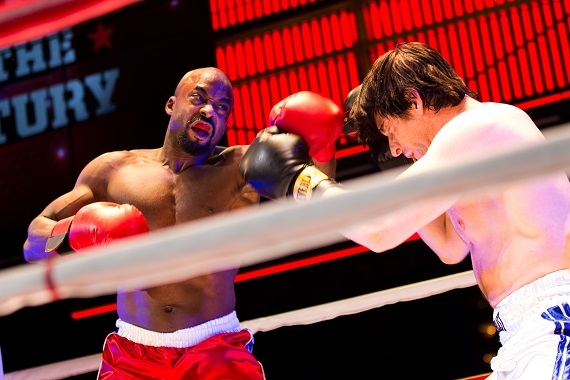Delivering the One-Two Punch of Fight Choreography in Rocky
Associate Fight Choreographer Patrick McCollum and cast member Kevin Del Aguila give us the inside scoop behind the boxing in Broadway’s new musical.

(© Matthew Murphy)
Choreographers generally find themselves standing on the precipice of a huge undertaking when beginning work on Broadway musicals. Now imagine adding fight sequences (the final of which lasts for 20 minutes), and the process becomes an entirely different sort of experience. Patrick McCollum, associate fight choreographer on Rocky, developed the fight sequences alongside choreographer Steven Hoggett (Kelly Devine also choreographed), participating in a boxing lab in London in 2012, before honing them for the Germany production that same year.
"It's about working on developing boxing technique with the actors, and then we also created ways that the actors can safely impact on each other in the show so it looks like a real fight," says McCollum. And, "it is essentially a real fight, so it's a lot of training with them and it's very precision-based."

(© Dirty Sugar Photography)
Though McCollum has served as a movement associate, dance supervisor, and associate choreographer in the past (Peter and the Starcatcher, Wicked, and Murder Ballad, respectively), he had never taken on a project that involved mirroring real fight sequences. In fact, when Hoggett asked him to be his associate on Rocky, he assumed he was referring to The Rocky Horror Picture Show.
"I had never fought in my life and I had never taken boxing, so when I found out about it I got into training at Gleason's, a famous boxing gym in Brooklyn, before heading out to London," McCollum recalls. "I love the way it's really just sort of humanity in movement. There's only four moves, and in looking at it from a dancer's background, it was a much simpler and more efficiently economical way to move."
There has been no shortage of boxing onstage recently with shows such as Golden Boy and Fetch Clay, Make Man where the story revolves around the popular sport. However, Rocky is the first musical to hit the stage that features the physical act of boxing itself. Kevin Del Aguila, a member of Rocky's ensemble, is not surprised by this fact.
"Integrating a sport into a show is challenging," Del Aguila says. "However, it would be difficult to stage an actual football or baseball game in a theater, but since boxing is between two people, it's possible to actually show it happening onstage. Not that it's easy! It's like a dance or stage combat; it's choreographed and rehearsed. But to give it authenticity, Steven Hoggett has figured out a way for the actors to make full contact. It's very exciting!"
McCollum recalls the initial challenge of working with the performers in the show. "It's a strange game to find athletic men who are dance-trained, but then who can also kind of strip down and leave the dancing at the door when they have to start boxing," he says, laughing. "It's a very tricky thing, especially when there's music and a beat happening underneath. You start to see them groove a little bit while they're boxing, and it's about telling them you just have to box and be technically proficient!"
McCollum feels that with Rocky, the choreography adds to this classic underdog tale, but never overshadows it. "It's about storytelling at its most simplistic and beautiful level and then when it's a spectacle, it's a spectacle. We're never pandering to a lowest common denominator. It's about a beautiful and simple story being told in a brilliant and intelligent way."
Similarly, Del Aguila recognizes that like most good sports stories, the heart of Rocky isn't just about the athleticism. "Rocky is a great love story told with boxing as a backdrop," he says. "The reason the final fight is so exciting is that it's not just a boxing match; it's the chance of a lifetime for Rocky. It's the opportunity everyone who's ever been down and out prays for. It's a living metaphor for the American dream."

(© Matthew Murphy)








